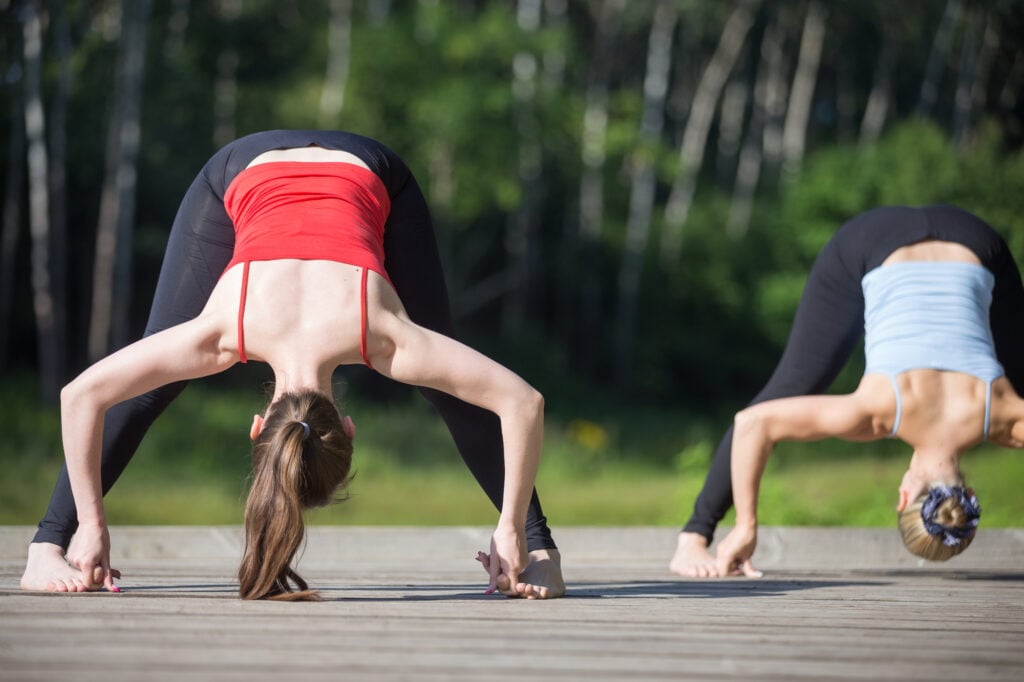Bend forward with the pleasent Prasarita Padottanasana

Prasarita Padottanasana is a standing pose, considered a half-inverted pose, that will challenge your confidence in yourself and teach you how to explore your limits.
A stretching pose, Prasarita Padottanasana will also work on your balance and the different versions in which we can practice it will focus on different aspects of the body.
If you want to know all the points you can work through this pose, keep reading and learn how to explore the Wide-legged forward bend.
Prasarita Padottasana: bend forward and find your balance
Prasarita Padottanasana is the original Sanskrit name of this pose, known in English as Wide-legged forward bend. It is usually in the end or close to the end of the standing positions, and it’s present on the first series of Ashtanga Yoga in four variations.
Consequently, the preparation poses are usually around Adho Mukha Svanasana, Supta Baddha Konasana, and Uttanasana. The following poses can diverse, but there are many practitioners connecting Prasarita Padottanasana with the handstand Adho Mukha Vrksasana, or the headstand Salamba Sirsasana II.
As mentioned before, this pose will not only improve your legs and lower-back flexibility, it will also improve your sense of balance. To understand it better, follow the step-by-step guide.
Prasarita Padottasana, a set-by-step guide
- Start by bringing with feet parallel, aligned by the outside lines. If you are not sure how far to keep your feet from each other, open or arms and measure it by the length between your wrists. Keep the arch of the feet high and active.
- Don’t over-extend your knees, and keep your quadriceps strong in order to protect your joints. Keep your hands on your hips and point your elbows backward.
- Activate the Mula Bandha, by contracting and raising your perineum muscles.
- Inhale, look up and exhale bend your torso with the intention of bringing the top of your head on the floor direction.
- Keep the tailbone turned up as much as possible.
- Roll the shoulders backward, bringing your shoulder blades closer.
- In possible, place the crown of your head on the floor.
- Keep the pose for at least five breaths, and if you want you can switch to the different variations.
- Pay close attention to the energy in the heart area, before you leave the pose.

Hands variations in Prasarita Padottanasana
- On the hips: elbows backward);
- On the floor: elbows bent and backward, don’t let them open to the sides);
- Hands behind your back: with fingers interlaced, palms together and away from the back (as much as possible);
- Holding the big toe.
Adaptations
In case you can’t reach the floor with your hands, you can use two blocks to place your hands. A common mistake when people can’t reach the floor is to bring the shoulders down. Remember that the movement comes from your hips, so that action on the shoulders just results in an illusionary idea that you are going deeper in the pose, and ends up in creating a lot of tension.
In case you are close, but you can’t still reach the floor with the crown of your head, use a block. Remember that you want to keep your spine as much aligned as possible, so keep the pressure on the blog and long your neck.
Going deeper
We have been highly referring to the balance that can be explored in this pose. To work on that balance, notice in the first place how you keep most of your weight on the heels. This action is natural, and we do it by protection.
Start putting more weight on your toes. It will challenge your sense of balance, but it will also allow you to go much deeper into the pose!
Benefits of Prasatira Padottanasana
Prasarita Padottasana comes with a set of benefits both spiritual and physical. On the subtle level, it works with the first three chakras: Muladhara, Svadisthana, and Manipura.
These chakras are connected to stability, productivity, and self-acceptance. By energizing and opening these chakras, it will help you energetically feeling more stable and comfortable with yourself.
It’s three main physical benefits are strengthening the legs and back, while it also stretches groins, hamstrings, and hips. It’s indicated for headaches and helps with digestion.
Although Prasarita Padottanasana is quite challenging, with time and dedication, it becomes a comfortable and pleasant pose.
You may also like:
- Ardha Ekapada Rajakapotasana: step-by-step of the Pigeon Pose
- A six step sequence to Ardha Chandrasana
- How to recover your joy with yoga for depression

